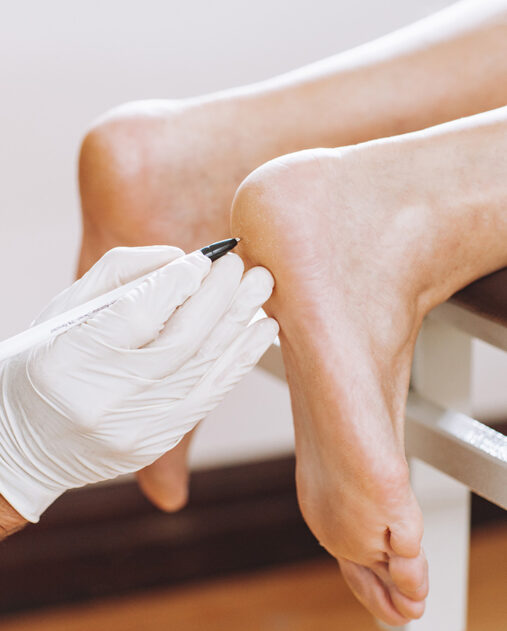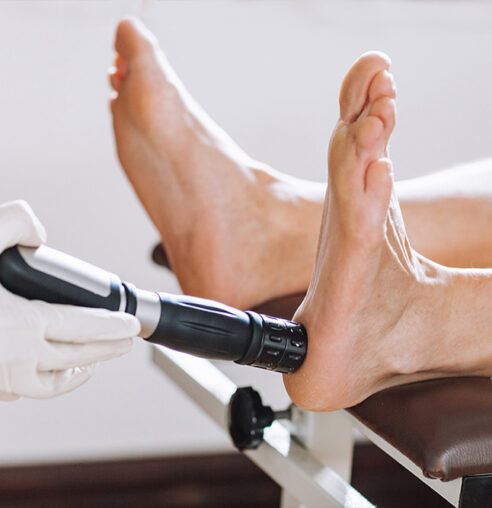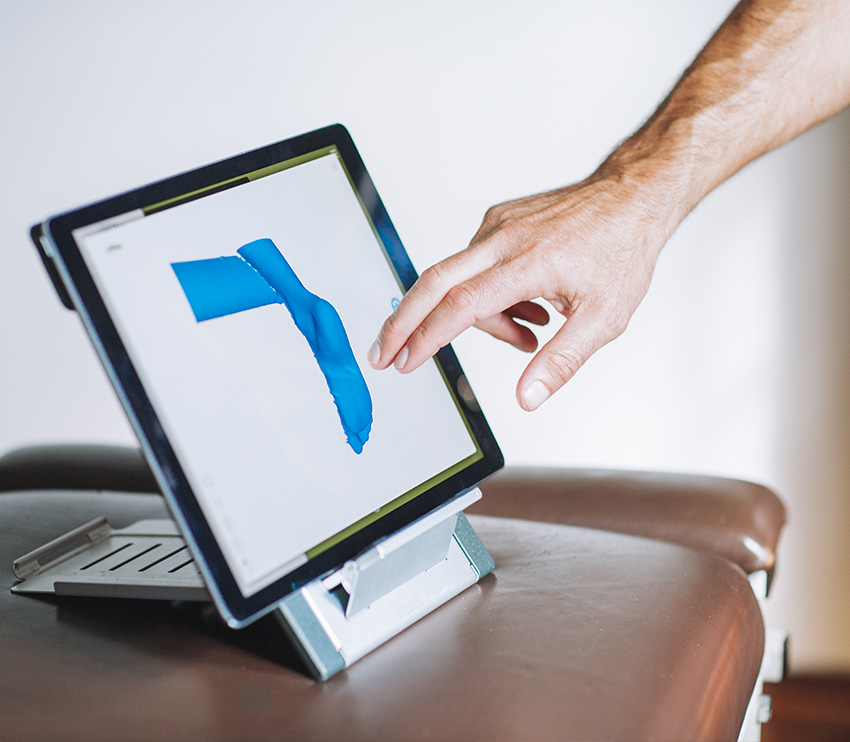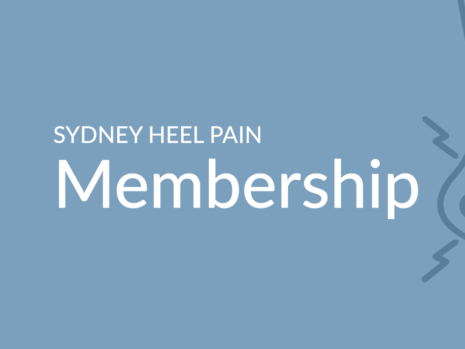Podiatrist Sydney CBD
Precision Led Treatment for Foot and Heel Pain
Access to precise, data-led podiatry care in Sydney CBD is critical to eliminating the mechanical drivers of persistent foot pain. At Sydney Heel Pain Clinic, we specialise in the biomechanical causes of foot and heel pain — and we base every diagnosis on measurable data, not assumption.
We do not offer skin or nail care. Our clinic is purpose-built for patients dealing with plantar fasciitis, Achilles tendon overload, nerve impingement, foot instability, and related musculoskeletal conditions of the lower limb.
Common Conditions We Treat
- Plantar fasciitis and chronic heel pain
- Achilles tendinopathy and calf overload
- Ball-of-foot pain (metatarsalgia) and Bunion pain
- Morton’s neuroma, nerve compression and Bursitis
- Arch collapse, flat feet, and mechanical fatigue
- Shin splints and medial tibial stress
- Midfoot instability and toe joint overload
- Load-related knee or hip pain originating from foot posture


Treatments and Technologies We Use
We use a combination of evidence-based interventions and diagnostic tools to address and treat the mechanical drivers of foot and heel pain:
A modern, evidence-backed therapy for cases involving chronic plantar fasciitis, tendon pain, or tissue overload. Shockwave therapy is used to stimulate vascular repair and disrupt pain cycles. No injections. No surgical recovery. Shockwave therapy provides a powerful, non-invasive treatment option.
Every patient undergoes motion analysis to measure how forces are absorbed through the foot and ankle during real-time movement. This data guides all treatment. We use advanced digital tools to assess your posture, movement, and foot strike patterns. It’s not guesswork, it’s measurement-based and precise.
If required, our orthotics are designed from your foot data using digital scanners which produce precise 3D scans. They are tailored to your gait mechanics and fabricated using 3D-printing technology for structural accuracy, which support the precise mechanics of your feet. These are not off-the-shelf inserts.
We don’t guess when it comes to shoes. Recommendations are based on the movement and loading patterns revealed during your assessment — This Tailored Footwear Guidance is often the key to reducing pain under load and supporting healing.
Restoring mechanical function requires active intervention beyond generalised stretching. Graduated load exposure is prescribed based on individual tissue capacity, mechanical thresholds, and compensatory patterns identified during assessment.
Many patients have already trialed cortisone injections, generic orthotics, or standard foot rehab without success. These cases often involve mechanical contributors that were missed or unaddressed in previous care.
Experience
Our clinic is led by Karl Lockett, a senior podiatrist with over 20 years of clinical experience, specialising in heel and arch pain. After graduating with honours from the University of Salford in Manchester in 1998, Dr. Lockett developed a strong clinical focus on biomechanics and foot function, helping thousands of patients overcome chronic foot pain.
He has previously lectured to podiatry students at the University of Western Sydney, sharing his expertise in heel pain and mechanical dysfunction. Since 2020, Dr. Karl has also been the podiatrist to the Sydney Opera House, providing professional podiatry services within one of Australia’s most iconic institutions.
Patients from across Sydney and beyond regularly seek his care, especially when standard treatments have failed.
How Our Sydney CBD Podiatry Clinic Approaches Diagnosis and Treatment
We don’t just manage symptoms — we isolate the mechanical barriers to recovery.
Dr Karl is known for his detective-like approach to diagnosis. Often, it’s a subtle habit, a foot posture during a daily task, or a misunderstood “home remedy” that’s keeping the pain from resolving. These details matter — and we know where to look.
This clinic focuses exclusively on the assessment and management of mechanical foot and lower limb conditions. Each treatment plan is based on clinical findings, biomechanical measurements, and the specific context of the patient’s lifestyle and movement demands.

Who We Help
We regularly work with patients from across Sydney and beyond, including:
- Office professionals walking or standing for long periods
- Recreational athletes and runners with overuse injuries
- Tradespeople and nurses dealing with occupational foot strain
- Older adults managing long-standing foot dysfunction
- Children, adolescents and teens with growth or posture-related pain
What to Expect at Your First Appointment
- Review of your pain history and previous treatments
- Movement screening and functional load analysis
- Digital gait and posture evaluation
- 3D foot scan
- Clinical diagnosis based on measurable data
- Tailored treatment plan and explanation of next steps
We provide diagnosis-led care, designed to identify the source of the problem and deliver long-term resolution — not just short-term relief.
Clinic Access
Our Sydney CBD podiatry clinic is located a short walk from Wynyard and Martin Place stations.
We also operate from Crows Nest and Parramatta, and offer telehealth consultations for patients in regional NSW, interstate, and overseas (including New Zealand and Fiji).
Why Timing Matters
Foot pain that becomes chronic rarely resolves on its own. Over time, it leads to compensatory movement, tendon overload, and progressive joint strain. Identifying the mechanical cause early gives patients a better chance of recovery — and avoids long-term dysfunction.
Frequently Asked Questions
Do I need a referral to see a podiatrist in Sydney CBD?
No referral is needed to see our podiatrist in Sydney CBD. You can book directly. If you’re being treated under an EPC plan from your GP, DVA, or workers’ compensation, we can process those referrals as well.
Can I claim treatment at your Sydney CBD podiatry clinic through private health insurance?
Yes. If your extras cover includes podiatry, you may be able to claim for consultations, 3D-printed orthotics, or shockwave therapy. Our Sydney CBD clinic has HICAPS available for on-the-spot claiming.
How long is the first consultation with your podiatrist in Sydney CBD?
Initial appointments typically run 30–50 minutes. This allows time for a detailed assessment, digital gait and load analysis, 3D foot scan if necessary, and treatment planning — all performed on site at our Sydney CBD podiatry clinic.
Do you provide treatment for children and adolescents at your Sydney CBD clinic?
Yes. Our podiatrist in Sydney CBD regularly treats children and teens with flat feet, growth-related pain, or postural issues. All care is age-appropriate and focused on long-term development and functional movement.
Is shockwave therapy available at your Sydney CBD clinic?
Yes. We offer shockwave therapy as part of our treatment options for conditions like plantar fasciitis and Achilles tendon pain. This service is available in-clinic at our Sydney CBD podiatry practice and satellite clinics.
What if I’ve already seen another podiatrist in Sydney CBD without improvement?
Many patients attend our clinic after standard care has failed. Our approach focuses on identifying overlooked mechanical factors that may be interfering with healing. We don’t just treat pain — we investigate and uncover why it persists.
Where can I find a podiatrist Sydney CBD locals recommend for biomechanical assessment?
Sydney Heel Pain Clinic is focused exclusively on diagnosing and treating mechanical causes of foot and heel pain. The clinic combines 3D scanning, gait analysis, and evidence-based interventions — not generalised care.
Unresolved foot pain requires a diagnosis supported by gait analysis, load mapping, and mechanical correlation.


